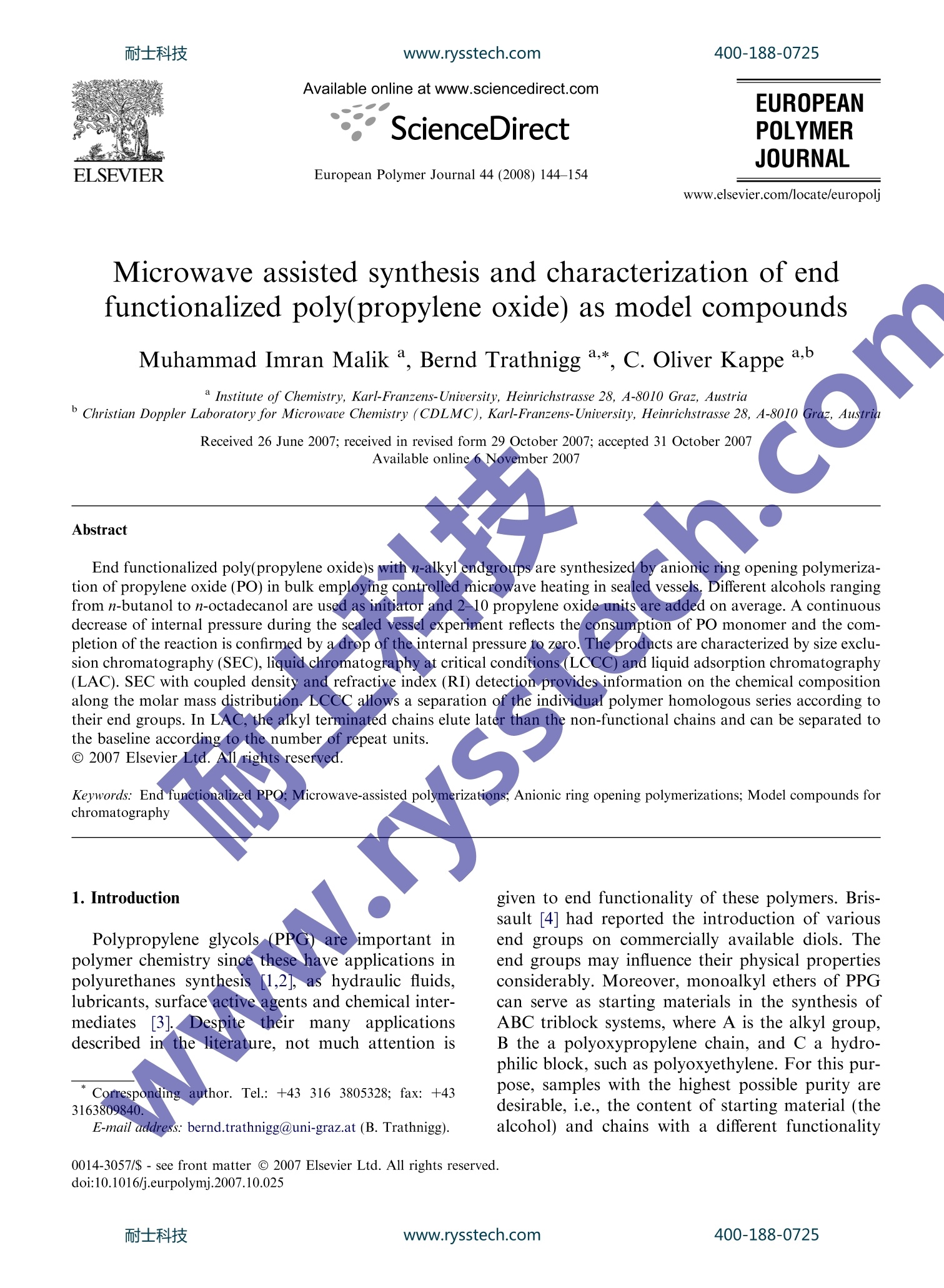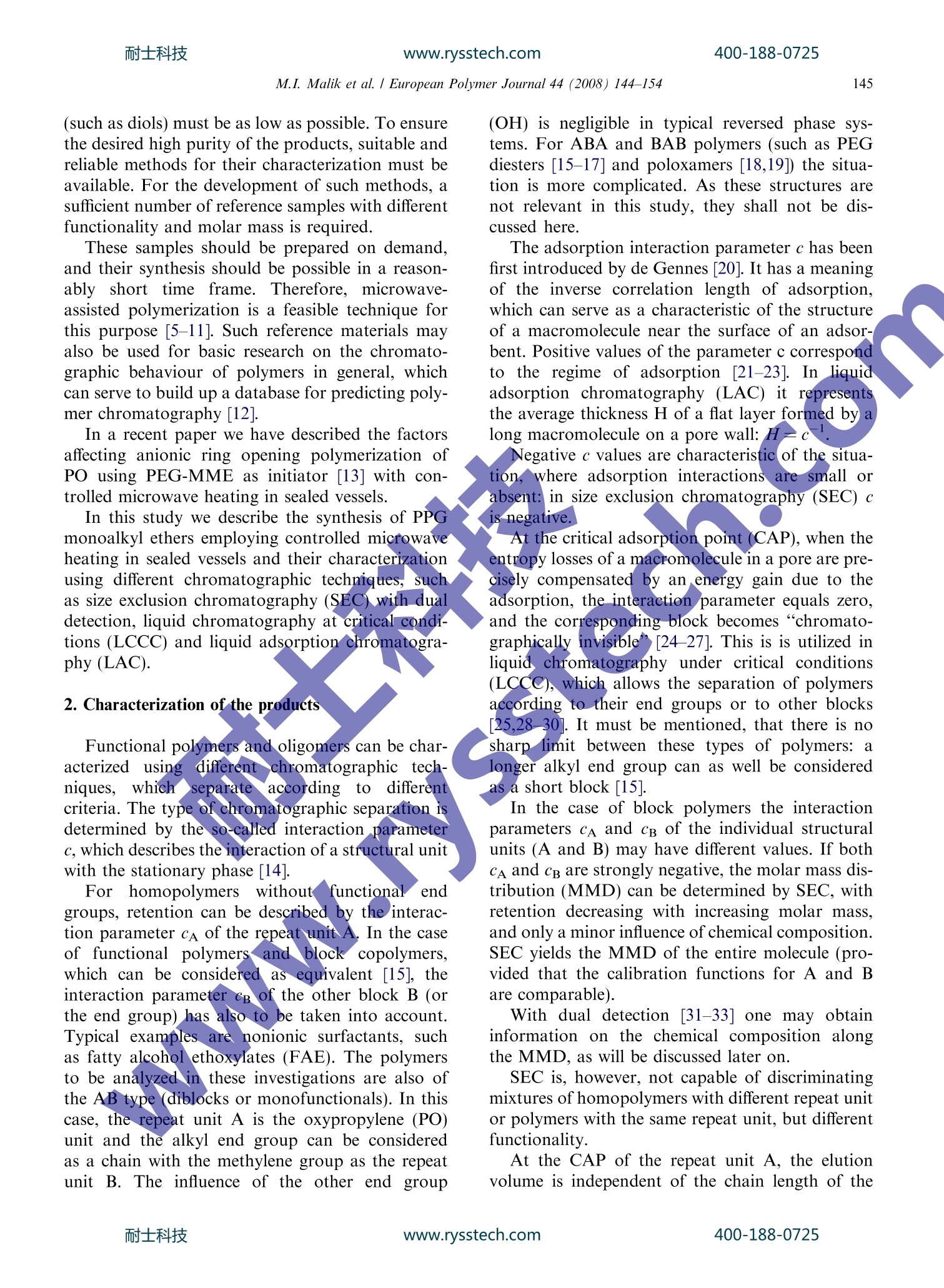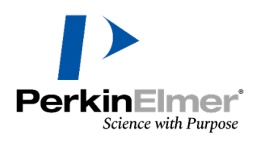使用Biotage微波合成仪进行微波条件下从酰化的2-氨基苯乙酮类化合物进行直接的微波合成得到2-芳基喹诺酮类化合物by耐士科技
检测样品 其他
检测项目 特殊物质和基团

 银牌会员
86 篇解决方案
银牌会员
86 篇解决方案
方案详情文
智能文字提取功能测试中
400-188-0725耐士科技www.rysstech.comAvailable online at www.sciencedirect.comScienceDirectEuropean Polymer Journal 44 (2008) 144-154 耐士科技400-188-0725www.rysstech.comM.I. Malik et al./ European Polymer Journal 44 (2008) 144-154145 EUROPEANPOLYMERJOURNAL ELSEVIER www.elsevier.com/locate/europolj Microwave assisted synthesis and characterization of endfunctionalized poly(propylene oxide) as model compounds Muhammad Imran Malik, Bernd Trathnigg a,*, C. Oliver Kappe a.b Institute of Chemistry, Karl-Franzens-University, Heinrichstrasse 28, A-8010 Graz, Austria Christian Doppler Laboratory for Microwave Chemistry(CDLMC), Karl-Franzens-University, Heinrichstrasse 28, 4-8010 Graz, Austria Received 26 June 2007;received in revised form 29 October 2007; accepted 31 October 2007Available online 6 November 2007 End functionalized poly(propylene oxide)s with n-alkyl endgroups are synthesized by anionic ring opening polymeriza-tion of propylene oxide (PO) in bulk employing controlled microwave heating in sealedvessels.Different alcohols rangingfrom n-butanol to n-octadecanol are used as initiator and 2-10 propylene oxide units are added on average. A continuousdecrease of internal pressure during the sye asleeadled vessel experiment reflects the consumption of PO monomer and the com-pletion of the reaction is confirmed by a drop of the internal pressure to zero.The products are characterized by size exclu-sion chromatography (SEC), liquid chromatography at critical conditions (LCCC) and liquid adsorption chromatography(LAC). SEC with coupled density and refractive index (RI) detection provides information on the chemical compositionalong the molar mass distribution. LCCC allows a separation of the individual polymer homologous series according totheir end groups. In LAC, the alkyl terminated chains elute later than the non-functional chains and can be separated tothe baseline according to the number of repeat units. @ 2007 Elsevier Ltd. All rights reserved. Keywords: End functionalized PPO; Microwave-assisted polymerizations, Anionic ring opening polymerizations; Model compounds forchromatography 1.Introduction Polypropylene glycols (PPG) areimportant inpolymer chemistry sinceotthese have applications inpolyurethanes synthesisJ1,2,], as hydraulic fluids,lubricants, surface active agents and chemical inter-mediates31. Despitettheir manyapplicationsdescribed in the literature, not much attention is ( * C o rre s pondin g author. Tel.: +43 316 3805328; fax: +43 316380 9 840 . ) ( E-mail a ddr ess: bernd.trathnigg@un i -gr a z.at (B. Trathnigg). ) given to end functionality of these polymers. Bris-sault [4] had reported the introduction of variousend groups on commercially available diols. Theend groups may influence their physical propertiesconsiderably. Moreover, monoalkyl ethers of PPGcan serve as starting materials in the synthesis ofABC triblock systems, where A is the alkyl group,B the a polyoxypropylene chain, and C a hydro-philic block, such as polyoxyethylene. For this pur-pose, samples with the highest possible purity aredesirable, i.e., the content of starting material (thealcohol) and chains with a different functionality ( 0014-3057/$- see front m atter @ 2007 Elsevier L t d. All rights r eserved.doi:10.1016/j.eurpolymj.2007.10.025 ) (such as diols) must be as low as possible. To ensurethe desired high purity of the products, suitable andreliable methods for their characterization must beavailable. For the development of such methods, asufficient number of reference samples with differentfunctionality and molar mass is required. These samples should be prepared on demand,and their synthesis should be possible in a reason-ably short time frame..Therefore, microwave-assisted polymerization is a feasible technique forthis purpose [5-11]. Such reference materials mayalso be used for basic research on the chromato-graphic behaviour of polymers in general, whichcan serve to build up a database for predicting poly-mer chromatography [12]. In a recent paper we have described the factorsaffecting anionic ring opening polymerization ofPO using PEG-MME as initiator [13] with con-trolled microwave heating in sealed vessels. For hhomopolymerswithouttffunctionaleendgroups, retention can be described by the interac-tion parameter cA of the repeat unit A.In the caseof functionalpolymers and block copolymers,which can be consideredas equivalent [15], theinteraction parameter cB of the other block B (orthe end group) has also to be taken into account.Typical examples are nonionic surfactants, suchas fatty alcohol ethoxylates (FAE). The polymersto be analyzed in these investigations are also ofthe AB type (diblocks or monofunctionals). In thiscase, the repeat unit A is the oxypropylene (PO)unit and the alkyl end group can be consideredas a chain with the methylene group as the repeatunit B. The influence of the other end group (OH) is negligible in typical reversed phase sys-tems. For ABA and BAB polymers (such as PEGdiesters [15-17] and poloxamers [18,19]) the situa-tion is more complicated. As these structures arenot relevant in this study, they shall not be dis-cussed here. The adsorption interaction parameter c has beenfirst introduced by de Gennes [20]. It has a meaningof the inverse correlation length of adsorption.which can serve as a characteristic of the structureof a macromolecule near the surface of an adsor-bent. Positive values of the parameter c correspondto the regime of adsorption [21-23]. In liquidadsorption chromatography (LAC) it representsthe average thickness H of a flat layer formed byyalong macromolecule on a pore wall: H=c-1 Negative c values are characteristic of the situa-tion.,where adsorption interactions are small orabsent: in size exclusion chromatography (SEC) c1s negative At the critical adsorption point (CAP), when theentropy losses of a macromolecule in a pore are pre-cisely compensated by an energy gain due to theadsorption, the interaction parameter equals zero.and the corresponding block becomes“chromato-graphically invisible [24-27]. This is is utilized inliquidchromatography under critical conditions(LCCC), which allows the separation of polymersaccording to their end groups or to other blocks[25,28-30]. It must be mentioned, that there is nosharp limit between these types of polymers: alonger alkyl end group can as well be consideredas a short block [151. In the case of block polymers the interactionparameters ca and CB of the individual structuralunits (A and B) may have different values. If bothcA and cg are strongly negative, the molar mass dis-tribution (MMD) can be determined by SEC, withretention decreasing with increasing molar mass,and only a minor influence of chemical composition.SEC yields the MMD of the entire molecule (pro-vided that the calibration functions for A and Bare comparable). With dual detection [31-33] one may obtaininformation on the chemical composition alongthe MMD, as will be discussed later on. SEC is, however, not capable of discriminatingmixtures of homopolymers with different repeat unitor polymers with the same repeat unit, but differentfunctionality. At the CAP of the repeat unit A, the elutionvolume is independent of the chain length of the block A. In this case, AB polymers can be separatedaccording to the block B. Basically, there are two options: if the interactionparameter cB of the block B is negative, it will eluteearlier than the homopolymer A in SEC order, if cBis positive, the block copolymer elutes later than thehomopolymer A in LAC order [18,19]. Obviously,the first situation will only be applicable, if the Bblock is sufficiently large. On the other hand, thesecond approach is limited to short blocks in thecase of strong interaction (i.e. large values of cB). Functional polymers can be separated by LCCCaccording to their end groups: all chains with thesame end group elute as a narrow peak at the samevolume, which will be the higher, the stronger theadsorption of the end group is. solvation of the polymer molecules would requirea third concentration detector, which is not avail-ole.The evaporative light scattering tor(ELSD) cannot be applied for this purpose becauseof its unclear response to copolymers. As has been shown previously [31,39], responsefactors of density and RI detection depend on chem-ical composition and molar mass. When a mass m; of a copolymer containing theweight fractions wA and wB (=1-WA) of the com-ponents A and B elutes in the interval i of the peakits composition (wA) can be calculated from theareas xi,obtained for this interval from both detec-tors, and the response factors fj,A and f,B wherein jdenotes the individual detectors In the analysis of AB copolymers (whether ran-dom or block) the sensitivity of the detector for Aand B may be very different. In this case, one willobtain erroneous results using just one detector. With a combination of two concentration detec-tors (such as RI, UV and density detector [38]) withdifferent response factors for the units A and B onemay obtain important information on chemicalcomposition and thus an accurate result. As the polymers to be analyzed in this study donot have any UV-absorbing groups, the combina-tion of density and RI detection is the method ofchoice. With amphiphilic copolymers, this works,however, only in SEC, where single mobile phasesare used. In mixed mobile phases the preferential From the composition of a fraction its mass can becalculated using Eq. (2) This approach can be utilized, if the response fac-tors fr.A and JiB are sufficiently different [31-33,40-431. In the analysis of functional polymers and oligo-mers another approach can be applied. If the end groups are chemically different fromthe repeat unit, the response factors depend onmolar mass: wherein f is the response factor of a molecule withthe molar mass Mi, f the response factor of the re-peat unit, and K is a constant describing the influ-ence of the end group. This allows an accurate quantification in SEC offunctional oligomers with just one detector. Theonly limitation is, that Eq. (3) can only be applied,if the sign of the response factor does not changewithin the peak. For functional polymers, both approaches areequivalent. In this study, we have preferred the dualdetector approach (using Eqs. (1) and (2)). LCCC is typically performed in mixed mobilephases, hence preferential solvation has to be takeninto account. This is not the case with the ELSD.but this detector is highly problematic in the analy-sis of lower oligomers, which may be not detected at all [44]. On the other hand, it is the only detector,which can be used to detect small amounts of homo-polymers, as these elute in LCCC together with thesolvent peak. If the individual oligomers can be sufficiently sep-arated by isocratic LAC and identified, a quantita-tive determinationis possible: underisocraticconditions, density or RI detection can be applied,and for these detectors, the response factors canbe calculated for each oligomer using Eq. (3). 4. Experimental 4.1. Polymerizations Propylene oxide (PO) and all alcohols (butanol,hexanol, octanol, decanol, dodecanol, tetradecanol,hexadecanol and octadecanol) were purchased fromFluka (Buchs, Switzerland). Sodium hydride (60%dispersion in mineral oil) from Aldrich was usedas received.Lower alcohols (butanol-decanol) weredried over anhydrous sodium sulfate while higheralcohols were used as received. The polymerization of PO was performedbyanionic ring opening using alcohols and sodiumhydride as initiator. All polymerizations were per-formed in 2-5 ml (filling volume) mirowave processABlvials (Biotage AB), which were oven dried undervacuum prior to use. The alcohol and NaH wereadded to the vials which were subsequently sealed with an aluminum crimp top and Teflon septum.The calculated volume of PO was added with a syr-inge through the septum. The quantity of sodiumhydride was 0.1% of total product, the quantitiesoOfI alcoholsand1 POindifferenitt experimentsdepended upon intended average number (2-10) ofPO units in the chain (calculated by molar ratios).The sealed microwave process vials were subse-quently introduced into the cavity of the single-mode microwave reactor (Biotage Initiator EightEXP 2.0, absorbance level: high). Time [min] Fig. 1. Internal pressure and temperature during the polymerization under microwave irradiation. At reaction temperatures of 160°C the initialpressure in the microwave process vial was typicallyin a range between 5 and 20 bar and decreased duringthe polymerization as PO was consumed. Due to thefact that PO has a boiling point of only 34.3°C theautogenic pressure generated by this starting mate-rial in combination with the online pressure monitor-ing of the microwave reactor [45] did provide a veryconvenient method for monitoring the conversion inthese solvent-free polymerization processes. All microwave-assisted polymerizations were car-ried out at 160°C to complete conversion, as indi-cated by a drop) of the internal pressure frominitially 5 to 20 bar to zero.Typically reactions take50-80 min for complete conversion (see Fig. 1) whilethe same experiment performed under conventionalheating takes almost 5 h. After polymerization theactive end was neutralized by adding an equimolarquantity of acetic acid. These investigations were performed using a den-sity detector (according to the mechanical oscillatorprinciple[46,47])DDS70 (CHROMTECH, Graz,Austria) in all chromatographic systems.Dataacquisition and processing was performed usingthe software CHROMA, which has been developedfor the DDS70. In SEC, we used a modular system consisting of aGynkotek 300 C pump, a VICI injector equippedwith a 100 pl sample loop, two column selectionvalves Rheodyne 7060 (Rheodyne, Cotati, CA,USA), a density detection system DDS 70 (Chrom-tech, Graz, Austria) coupled with a Bischoff 8110refractive index detector (Bischoff, Leonberg, Ger-many). SEC measurements were performed on a7.8× 600 mm Phenogel 100A column (Phenomenex,Torrance, CA, USA))or a7.8×300mm PLgelMIXED E column (Polymer Laboratories, ChurchStretton, Shropshire,UK) at a fOW-rate of1.00 ml/min. Sampleecconcentrations were 3.0-10.0 g/l. The columns were calibrated with PPGsfrom Sigma-Aldrich and FLUKA (Buchs, Switzer-land). Molar mass distributionswere calculatedusing CHROMA. In LCCC, the mobile phase was delivered byanISCO 2350 HPLC pump (ISCO, Lincoln, NE,USA) at a flow rate of 0.5 ml/min. Samples wereinjected using an autosampler Spark SPH 125 Fix(SparklHolland. Emmen. TheNetherlands)equipped with a 20 pl loop. A refractive index detec-tor RI 2414(Waters) or a SEDEX 45 ELSD (Sedere,France) was connected to the DDS 70. Nitrogen wasused as carrier gas, and the pressure at the nebulizerwas set to 1.0 bar. Evaporator temperature: 30 °C.All separations in LCCC were performed on a JordiGel DVB 500 RP column (100% poly-divinylben-zene; 250×4.6 mm; particle diameter=5um; poresize= 500 , from Jordi, Bellingham,MA, USA). In LAC the mobile phase was delivered by a JAS-CO 880 PU pump (from Japan Spectrosopic Com-pany, Tokyo, Japan) at a flow rate of 0.5 ml min.Samples were injected manually using a Rheodyne7125 injection valve (from Rheodyne, Cotati, CA,USA) equipped with an 50 pl loop. A Waters 2414refractive index (detector (Waters, Milford, MA,USA) was connected to the DDS 70. Columns wereconnected to two column selection valves (Rheodyne7060, from Rheodyne, Cotati, CA,USA). All LACseparations were performed on a Prodigy ODS3 col-umn (from Phenomenex, Torrance, CA, USA): sil- ica-based octadecyl phase; 250×4.6 mm; particlediameter =5 um; pore size=100, surface area:450 m²/g, carbon load: 15.5%. In all systems, the columns and density cells wereplaced in a thermostatted box, in which a tempera-ture of25.0 °C was maintained for all measurementsin LCCC and LAC and 30.0C in SEC. Mobile phases were mixed by mass and vacuumdegassed, their composition was controlled by den-sity measurement using a DMA 60 density meterequipped with a measuring cell DMA 602 M (A.Paar, Graz, Austria). The solvents (chloroform, THF, acetone andwater, all HPLC grade) were purchased from Roth(Karlsruhe, Germany) and Merck (Darmstadt, Ger-many). PEG and PPG standards were purchasedfrom Sigma-Aldrich and FLUKA (Buchs.Switzerland). 5. Results and discussion In the case of end-functionalized PPG one mayexpect (besides residual alcohol) mainly two otherhomologous series as side products: PPG diols(resulting from chain transfer to traces of water inthe starting materials) and allylic PPG (which isformed by chain transfer to the monomer) [13,48]. The residual alcohol can be identified and deter-mined quantitatively by SEC on a column with nar-row pores, as it is sufficiently smaller than the firstoligomer. Some unreacted alcohol can be found in sampleswith a low ratio of PO to alcohol, while it com-pletely disappears in samples with (on average) 5or more PO units, as can be seen in Fig. 2. SEC with dual detection can be applied to deter-mine the PO content along the MMD: in a lowmolecular sample with a short alkyl end group,where the individual oligomers can be at least par-tially resolved, a stepwise increase of the PO content(corresponding to the chemical composition of theoligomers) can be observed, as is shown in Fig. 3. Higher molecular samples or those with a longeralkyl end group (in which the individual oligomerscannot be resolved any more) show also the increaseof PO with molar mass, and at the low molecularend one may see the presence or absence of residualalcohol as is shown in Fig.4. Fig. 5 shows the MMD of two different hexa-decyl-PPGs with a different number of repeat units(5 and 10 on average). As can be seen, both samplescontain only traces of the starting alcohol. moFig. 2. Overlay of SEC chromatograms with n-dodecanol as starting block (density detector).c Molar mass, M [g/mol] Fig. 3. MMD and chemical composition of a product with n-butanol as starting block, as obtained from SEC with dual detection. Of course, PPG diols and allylic PPG will not beidentified, and if they would be present in consider-able amounts, they would seriously affect the accu-racy of the MMD obtained from SEC. Thisinformation Can only be obtainedfrom LCCC. At the CAP for PO, the elution vol-ume of each series is independent of molar mass.PPG diols and allylic PPG are separated fromeach other (due to the adsorption of the allyl group)[13]. If the alkyl group is long enough, it is adsorbedmore strongly than the allylic group, and thealkyl-terminated PPG can also be separated fromthe allylic PPG. This is a different situation from the EO-POdiblocks described recently [13,18,19], where theEO block elutes in the exclusion mode (earlier thanthe diols). Fig. 6 shows the elution volumes of the individ-ual homologous series with different molar mass M.I. Malik et al./ European Polymer Journal 44 (2008)144-154 mo. Fig. 4. MMD and chemical composition of a product with n-hexadecanol as starting block, as obtained from SEC with dual detection. Fig. 5. Overlay of MMD of PPGs with hexadecyl end group, as obtained from SEC with dual detection. (M vs. V). As can be seen, the elution volumes ofPPGs with the same end groups are almost indepen-dent of molar mass (except for those with C16 andC18 end groups), which indicates, that this mobilephase composition does not exactly correspond tothe critical point, but it is close enough to theCAP to allow a good separation of PPGs with anend group of 10 or more carbon atoms from the allyl-termined PPGs and the PPG diols. The peaksof polymers with short alkyl end groups (like butyland hexyl) may overlap with the peak of the allyl-PPGs, but PPGs with longer alkyl end groups (suchas decyl, dodecyl, hexadecyl and octadecyl) elutelater and are thus clearly separated from the allyl-terminated PPGs. All alkyl PPGs are, however,clearly separated from the diols. Fig. 6. LCCC: Molar mass vs. elution volume, as obtained on the Jordi column in 80 wt% THF-water, flowrate 0.5 ml/min, detection:ELSD. Elution volume (mL) Fig. 7. LCCC of products with decyl end group, as obtained on the Jordi column in 80 wt% THF-water, flowrate 0.5 ml/min, detectionELSD. the other homologous series, the one with n=5contains only traces of them. Fig. 7 shows chromatograms of a sample withdecyl end groups, which obviously contains diols,but no allylic PPG. This sample was spiked withallylic PPG, which had been prepared by propoxyla-tion of allyl alcohol (in the same way as the alkylPPGs).Ascan be seen, allyl-terminated PPGappears as a sufficiently resolved peak. Fig. 8 shows a comparison of two samples withOCc1tadecyl end ggrroups::while the samplewithn=10 PO units contains considerable amounts of While the diols can be minimized by dryingreagents and glassware carefully, the allylic chainscannot be easily avoided, as they are formed by achain transfer reaction to the monomer. As hasbeen shown previously [13,48], this reaction can bemore or less suppressed by a sufficiently high con-centration of hydroxy groups. In the case of thealcohols this is fulfilled quite well: the amount of M.I. Malik et al. / European Polymer Journal 44 (2008) 144-154 mo. Fig. 8. LCCC of products with octadecyl end group, as obtained on the Jordi column in 80 wt% THF-water, flowrate 0.5 ml/min,detection: ELSD. Fig. 9. Overlay of LAC chromatograms of mono-hexyl PPGs and hexanol. Prodigy ODS3, 70.83 wt% acetone-water, RI detection. allyl-terminated PPG is quite low in most of thesamples. oligomers of PPG and lower alcohols (up to deca-nol) are, however, not detected by ELSD. The main problem in these separations is quanti-fication: if LCCC is run in THF-water, the responsefactors of density and RI detection for PPG (regard-less their functionality) are poor, as the difference indensity and refractive index between sample andmobile phase is too small. Hence the ELSD has tobe used, which is much more sensitive. The lowest Additional information can be obtained by usinga mobile phase, in which both interaction parame-ters (PO and alkyl) are positive. This is the caseon ODS columns in acetone-water mobile phaseswith about 70-85 wt% acetone. Depending on thenature of the end groups, different mobile phasecompositions must be applied. If the interaction of 25 Elution volume (mL) the end group is strong, the interaction of the repeatunit may be rather weak. For such functional polymers, a baseline separation of the individual oligo-mers in LAC mode is achieved, where this wouldnot be possible with the homopolymers. In Fig. 9 the chromatograms of two hexyl-termi-nated PPGs and hexanol are shown. As can be seen.the hexyl PPGs elute in LAC order [49] with a base-line separation of the individualoligomers. Allpeaks of the C6 series can be identified (as indicatedby the numbers above cach peak). The first series ofpeaks (which contains the allyl PPGs) is separatedfrom the hexyl-PPGs (except for hexanol). In thismobile phase, RI detection can be applied, whichmakes quantification much easier [50]. Fig. 10 shows a comparison of chromatograms·obtained on the Prodigy column in :80.22 wt% ace-tone: for mono-dodecyl PPG a baseline resolutionof all oligomers is achieved, while mono-allyl PPGand PPG diols elute close to the solvent peak anddo not overlap with the dodecanol peak. Conse-quently, all oligomers of dodecyl-PPG can be quan-tified from RI detection, as will be shown in anotherpaper. Moreover, these chromatograms yield the inter-action parameters of the PO unit may be determinedin the range of rather weak interaction, which couldnot be achieved with non-functional chains. Thedata thus obtained can be used to build up a database for predicting polymer chromatography, whichwill be the subject of a forthcoming publication. End functionalized (alkyl) PPO with an averagenumber of 2-10 PO units and good purity can besynthesized inbulkusing controlled microwavedielectric heating in sealed vessels. The requiredtotal reaction times at 160°C are only 50-80 min..This makes it very feasible and very convenient toproduce model compounds for LAC. These prod-uctsare sufficiently pure to be used as startingdiblock for synthesis of very interesting amphiphilictriblock architectures. A combination of SEC withcoupled density and RI detection with LCCC is avery useful tool for complete characterization ofend functionalized PPG. Acknowledgements M.I.M. thanks the Higher Education Commis-sion of Pakistan for a Ph.D. scholarship. Mag. Jen-nifer M. Kremsner isISacknowledged for someexperimental assistance. We also thank Biotage AB(Uppsala, Sweden) for providing the microwaveinstrumentation. References [1] Gagnon SD. In: Jacqueline Kroschwitz I, editor. EncyclPolym Sci Eng. New York: Wiley; 1986. p. 273-307. [2] Asha SK, Thirumal M, Kavitha A, Pillai CKS. Eur Polym J2005:41:23-33. ( [3] O'Sickey MJ, Lawrey BD, W ilkes G L. J Appl P o lym Sci2002;84:229-43. ) ( [4] Brissault B, G uis C , Cheradame H . M a cromolecules 2005;38:8244-51. ) ( [5] Wiesbroc k F , Hoogenboom R, Schubert US. MacromolRapid Commun 2004;25:1739-6 4 . ) ( [6] Yu Z , L iu L . J B iomater Sci Polym Ed 20 0 5;16:957-71. ) ( [7] SinnwellS, Ritter H. Macromol Rapidd Commun 2006;27:1 3 35-40. ) ( [8] Hoogenboom R , W iesbrock F, Huang H, L eenen M AM, Thijs HML, V an Nispen SFGM, et al. Macromolecules2006;39:4719-25. ) ( [9] Zhang C, Liao L, Gong SS. Macromol Rapid Commun 2007;28:422-7. ) ( [10 ] L i H , Lia o L , Liu L. Macromol F Rapid Commun 2007;28:411-6. ) ( [11] Hoogenboom R, S chubert US. Macromol Rapid Commun 2007:28:368-86. ) ( [12] Trathnigg B, Malik MI, Jamelnik O, Cuong NV. A n al Chim Acta. Papers presented at the 3rd Internationa l Symposium on t he Separation and Characterization of Natural and Synthetic Macromolecules, S CM-3, vol. 604;2007. p . 39-44. ) ( [25] Skvortsov AM. Gorbunov AA J Chromatogr 1990;507:487-96. ) ( [26] Belenkii BG, Gankina ES, Zgonnik VN, Malachova I I ,Melenevskaya EU. J Chromatogr 19 9 2;609:355-62. ) ( [27] Pasch H. Macromol Symp 19 9 6;110:107-20 . ) ( [28] Gorshkov A V, Much H, Becker H, Pasch H, Ev r einov VV , Entelis SG. J Chromatogr 1990;523:91- 10 2. ) ( [29] Pasch H, Zammert I . ( . J J L iq Chromatogr 1 994;17:3091-108. ) ( [30] Skvortso v AM, Gorbunov AA, Berek D , T r athnigg B . Polymer 1998;39:423-9. ) ( [31] T r athnigg B. J Liq Chromatogr 1 9 90;13:1731-4 3 . ) ( [32] T r athnigg B . J Chromatogr 19 9 1;552:507-16. ) ( [33] T rathnigg B, F eichtenhofer S, Kollroser M. J Chromatogr A1997;786:75-84. ) ( [34] Trathnigg B, Gorbunoy AA. J Chromatogr A 2001;910:207-16. ) ( [35] Trathnigg B , Rappe l C, Raml R, Gorbunov A A. J Chro-matogr A 2002;953:89 - 99. ) ( [ 36 T ] rathnigg B, Fraydl S, Veronik M. A . J Chromatogr A 2 004:1038:43-52. ) ( [3 7 7 ] 1 Lacharme F , L apeyre V, Ravaine V. J Chromatogr A 2005;1074:89-98. ) ( 381 T rathnig g B, Yan X. . ( Ch r omat o graphia 19 9 2;33:467-72. ) ( [ 3 9 ] T ra t hnigg B, Thamer D , Yan X, M aie r B, Holzbauer HR, M uch H. JChromatog r A 19 9 3;657:3 6 5-7 5 . ) ( [4 0 ] Trathnig g B, T h amer D, , Y a n X , K inugasa S . J L iqChromatogr 1993;16:2453-6 7 ) ( [ 41] Trathnigg B , Y a n X . J Chro m atogr A 1 9 93;653:199-206. ) ( [42] Trathnigg B , Y a n X .J A p pl Polym Sci: Appl Polym Symp 1 9 9 3:52:193 -2 03. ) ( [43] Pasch H , T r athn ig g B . H p lc of polymers. Be r lin: S p ringer; 1 9 97. ) ( [44 ]T rath n igg B. Kollroser M J Chromatogr A 1 997: 768 :2 23-38. ) ( [ 45] ] K appe C O. A n gew Chem Int Ed 2004;43:6250-84. ) ( [461 5] Leop o ldH, T rathnigg B. Angew Makromol( Chem 1 97 8;68:185-97. ) ( 4 7 Trathnigg B . Monatsh Chem 19 7 8;109:467-75 . ) ( [ 4 8] Becker H, Wagner G , S tolarzewicz A. A cta ta P P olym 1982;33:34-7. ) ( [49] Trathnigg B. Skvortsov A J Chromatogr A 2006;1127:117-25. ) ( [50] Trathnigg B. J Chromatogr A 2 001;915: 1 55-66. ) 耐士科技www.rysstech.com 耐士科技www.rysstech.com
关闭-
1/11

-
2/11

还剩9页未读,是否继续阅读?
继续免费阅读全文产品配置单
上海鑫欣生物科技有限公司为您提供《使用Biotage微波合成仪进行微波条件下从酰化的2-氨基苯乙酮类化合物进行直接的微波合成得到2-芳基喹诺酮类化合物by耐士科技》,该方案主要用于其他中特殊物质和基团检测,参考标准《暂无》,《使用Biotage微波合成仪进行微波条件下从酰化的2-氨基苯乙酮类化合物进行直接的微波合成得到2-芳基喹诺酮类化合物by耐士科技》用到的仪器有null。
我要纠错
相关方案
 咨询
咨询



